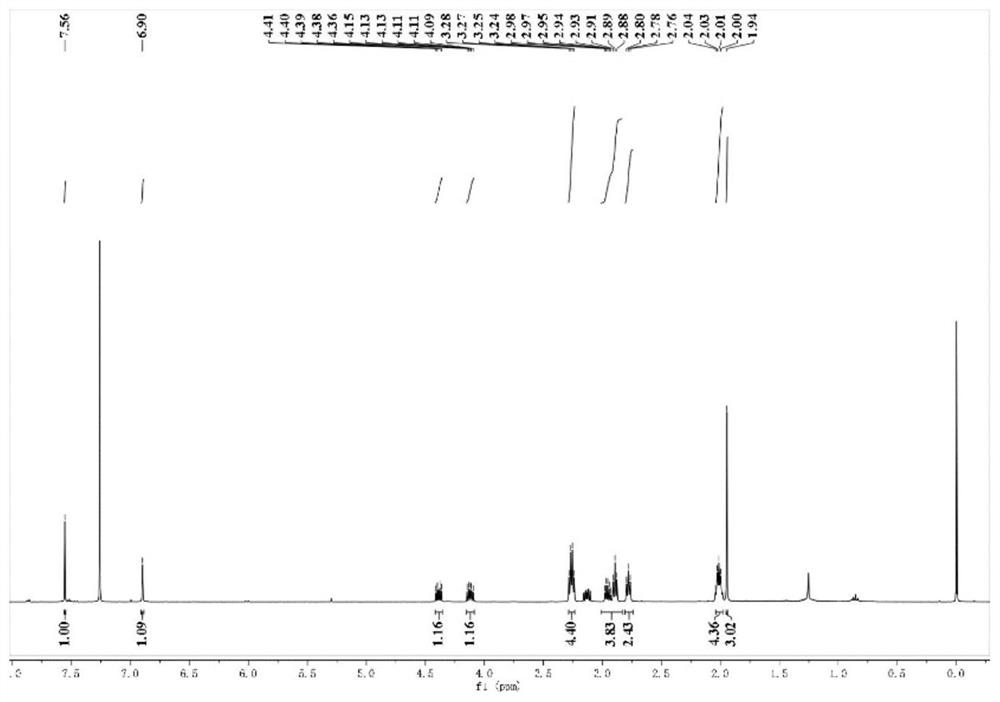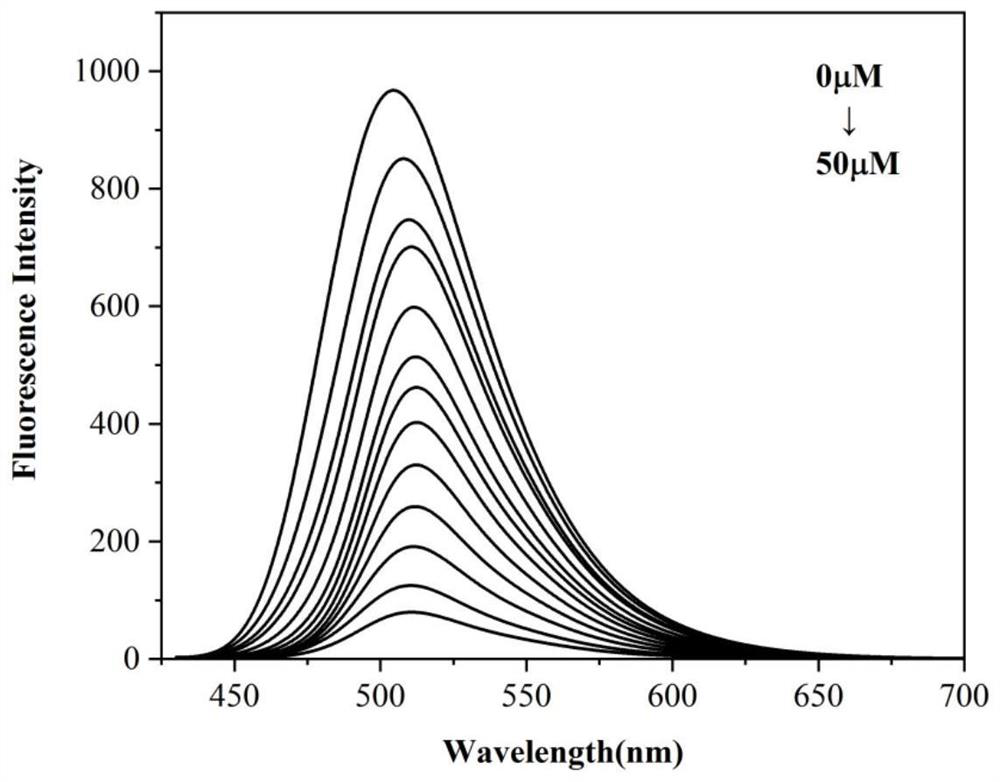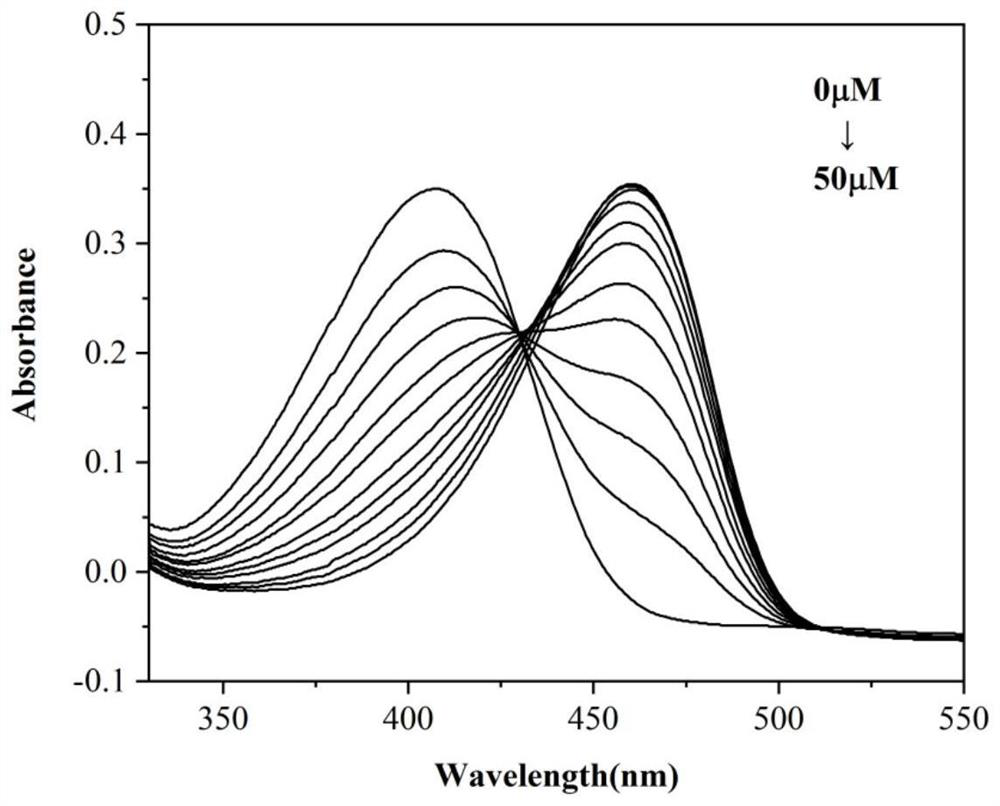Micromolecular fluorescent probe for detecting hypochlorous acid, and preparation method and application thereof
A technology for detecting hypochlorous acid and fluorescent probes, which is applied in the fields of fluorescence/phosphorescence, chemical instruments and methods, and analytical materials. It can solve the problems of poor selectivity and sensitivity, and achieve rapid response, good selectivity, and strong selectivity. Effect
- Summary
- Abstract
- Description
- Claims
- Application Information
AI Technical Summary
Problems solved by technology
Method used
Image
Examples
Embodiment 1
[0035] Embodiment 1: the synthesis of fluorescent probe molecule of the present invention:
[0036] The synthesis of the coumarin derivative shown in formula (III):
[0037] 8-hydroxyl-ninelonidine-9-formaldehyde (0.6518g, 3mmol), ethyl acetate (0.7748g, 3mmol) and piperidine (0.5ml, 3mmol) shown in formula (II) were dissolved in 24mL of anhydrous in ethanol. The mixture was heated and refluxed for 6 hours, then cooled to room temperature. The suspension was then collected by filtration and washed with cold absolute ethanol. Finally, the product was dried under vacuum to obtain orange crystals, and the coumarin derivative represented by formula (III) (0.6715 g, 79%) was obtained.
[0038] 1H NMR (400MHz, CDCl3-d1) δ (ppm): 8.31 (s, 1H), 6.94 (s, 1H), 3.33–3.30 (t, 4H), 2.86–2.84 (t, 2H) ),2.76–2.74(t,2H),2.64(s,3H),1.97–1.93(m,4H).13C NMR(CDCl3-d1,125MHZ)δ(ppm):196.08,161.33,153.85,148.82,147.87 ,127.84,119.60,114.96,108.13,105.70,50.01,30.70,27.49,21.20,20.12.HRMS(ESI+):...
Embodiment 2
[0042] Embodiment 2: In the present invention, measure the fluorescence spectrogram of organic molecule fluorescent probe:
[0043]The concentration gradient of hypochlorous acid is controlled by PBS buffer solution, and hypochlorous acid with a concentration gradient of 0-50 μM is sequentially added to a 10ml colorimetric tube, and then 10 μM probe is added, the solution is shaken, and after equilibrating at 37°C for 10 minutes, the above The mixed working solution was added to a fluorescent dish to measure the fluorescence spectrum. Under 470nm excitation, the fluorescence intensity curve changes with hypochlorous acid as figure 2 shown.
[0044] Depend on figure 2 It can be seen that as the concentration of hypochlorous acid increases, the fluorescence intensity of the reaction system decreases rapidly; when the concentration of hypochlorous acid reaches 50 μM, the fluorescence of the reaction system is almost completely quenched. Therefore, the probe has good responsi...
Embodiment 3
[0045] Embodiment 3: The ultraviolet-visible spectrometry of organic molecular fluorescent probe of the present invention and HOCl interaction:
[0046] The instrument used for the determination of ultraviolet-visible absorption spectrum is Shimadzu UV-2600 ultraviolet-visible spectrophotometer.
[0047] Configure hypochlorous acid (0-50 μmol / L) with different concentration gradients, add 10 μM probe to it, shake the solution, and measure its absorption peak by ultraviolet-visible spectrophotometer. The measurement results are as follows: image 3 shown.
[0048] from image 3 It can be seen that with the increase of hypochlorous acid concentration (0-50 μmol / L), the absorption peak of the probe at 470 nm gradually decreases, the absorption peak at 410 nm gradually increases, and an isosbestic point is formed at 430 nm. This indicates that the addition of hypochlorous acid generates new compounds.
PUM
 Login to View More
Login to View More Abstract
Description
Claims
Application Information
 Login to View More
Login to View More - R&D
- Intellectual Property
- Life Sciences
- Materials
- Tech Scout
- Unparalleled Data Quality
- Higher Quality Content
- 60% Fewer Hallucinations
Browse by: Latest US Patents, China's latest patents, Technical Efficacy Thesaurus, Application Domain, Technology Topic, Popular Technical Reports.
© 2025 PatSnap. All rights reserved.Legal|Privacy policy|Modern Slavery Act Transparency Statement|Sitemap|About US| Contact US: help@patsnap.com



